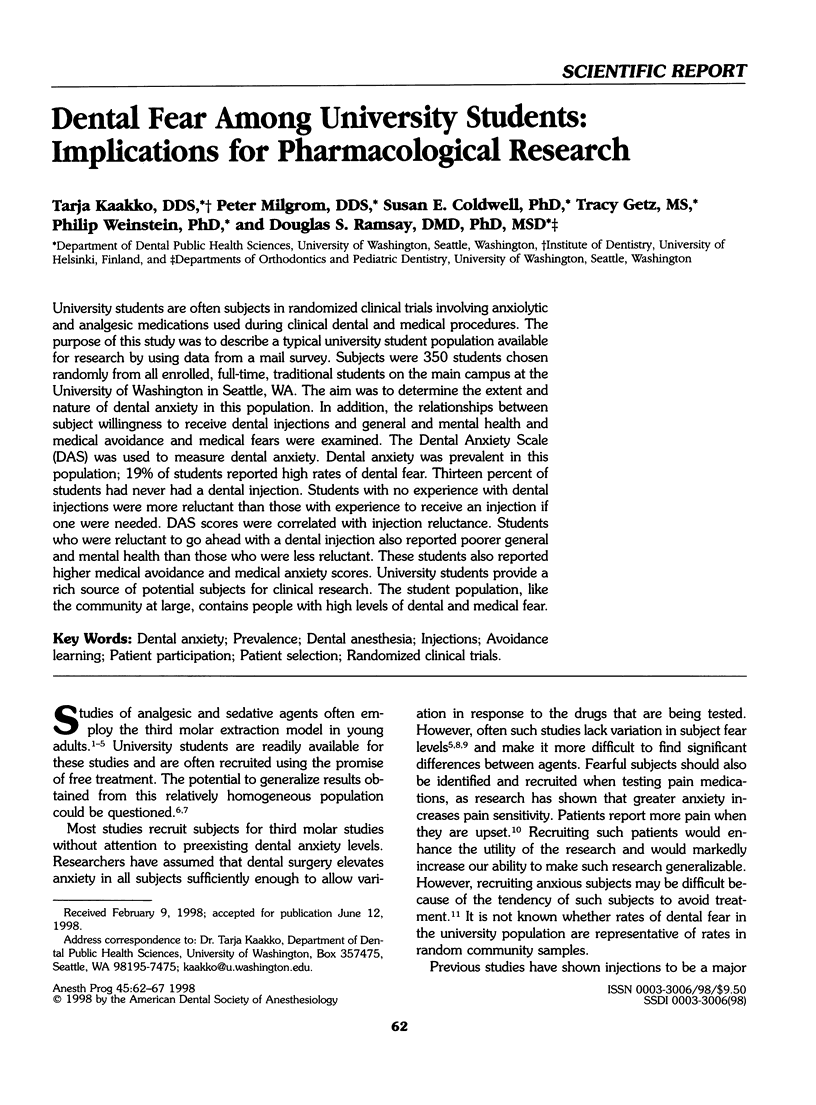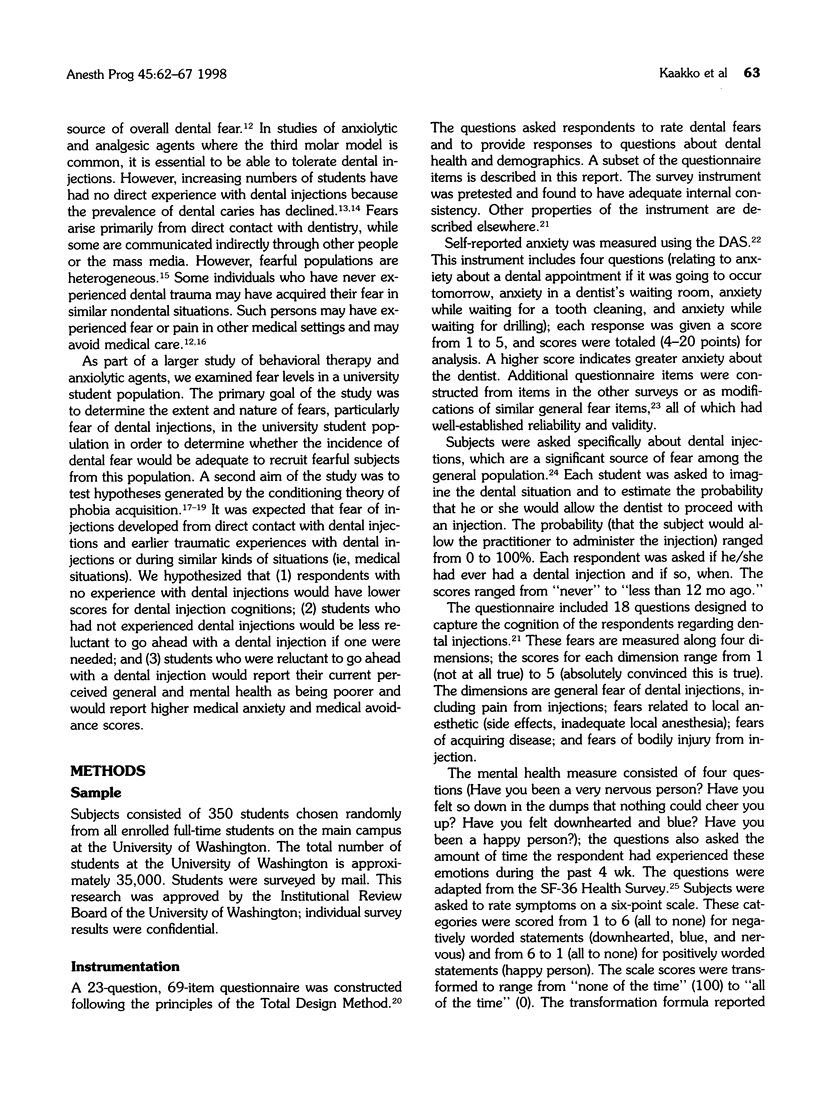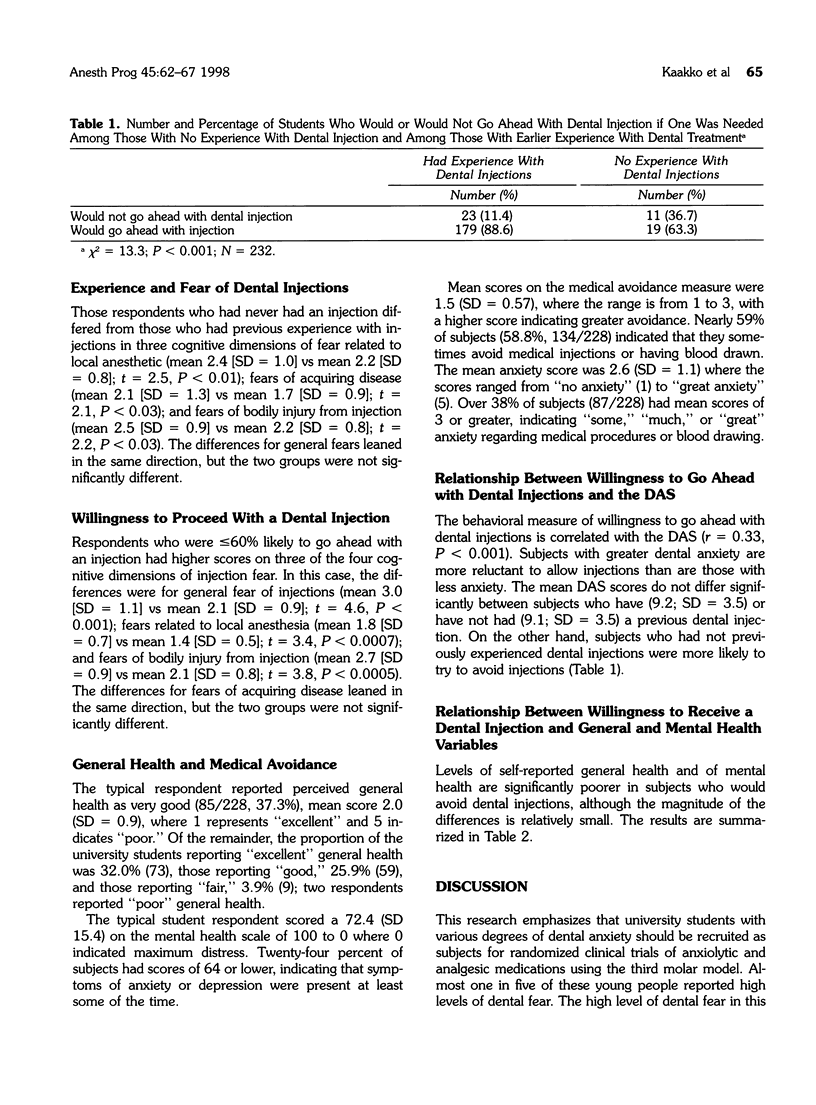Abstract
University students are often subjects in randomized clinical trials involving anxiolytic and analgesic medications used during clinical dental and medical procedures. The purpose of this study was to describe a typical university student population available for research by using data from a mail survey. Subjects were 350 students chosen randomly from all enrolled, full-time, traditional students on the main campus at the University of Washington in Seattle, WA. The aim was to determine the extent and nature of dental anxiety in this population. In addition, the relationships between subject willingness to receive dental injections and general and mental health and medical avoidance and medical fears were examined. The Dental Anxiety Scale (DAS) was used to measure dental anxiety. Dental anxiety was prevalent in this population; 19% of students reported high rates of dental fear. Thirteen percent of students had never had a dental injection. Students with no experience with dental injections were more reluctant than those with experience to receive an injection if one were needed. DAS scores were correlated with injection reluctance. Students who were reluctant to go ahead with a dental injection also reported poorer general and mental health than those who were less reluctant. These students also reported higher medical avoidance and medical anxiety scores. University students provide a rich source of potential subjects for clinical research. The student population, like the community at large, contains people with high levels of dental and medical fear.
Full text
PDF





Selected References
These references are in PubMed. This may not be the complete list of references from this article.
- Brown L. J., Selwitz R. H. The impact of recent changes in the epidemiology of dental caries on guidelines for the use of dental sealants. J Public Health Dent. 1995;55(5 Spec No):274–291. doi: 10.1111/j.1752-7325.1995.tb02382.x. [DOI] [PubMed] [Google Scholar]
- Coldwell S. E., Milgrom P., Getz T., Ramsay D. S. Amnestic and anxiolytic effects of alprazolam in oral surgery patients. J Oral Maxillofac Surg. 1997 Oct;55(10):1061–1070. doi: 10.1016/s0278-2391(97)90280-9. [DOI] [PubMed] [Google Scholar]
- Corah N. L. Development of a dental anxiety scale. J Dent Res. 1969 Jul-Aug;48(4):596–596. doi: 10.1177/00220345690480041801. [DOI] [PubMed] [Google Scholar]
- Dionne R. A., Snyder J., Hargreaves K. M. Analgesic efficacy of flurbiprofen in comparison with acetaminophen, acetaminophen plus codeine, and placebo after impacted third molar removal. J Oral Maxillofac Surg. 1994 Sep;52(9):919–26. doi: 10.1016/s0278-2391(10)80068-0. [DOI] [PubMed] [Google Scholar]
- Kaakko T., Milgrom P., Coldwell S. E., Getz T., Weinstein P., Ramsay D. S. Dental fear among university employees: implications for dental education. J Dent Educ. 1998 Jun;62(6):415–420. [PubMed] [Google Scholar]
- Kallio A., Salonen M., Forssell H., Scheinin H., Scheinin M., Tuominen J. Medetomidine premedication in dental surgery--a double-blind cross-over study with a new alpha 2-adrenoceptor agonist. Acta Anaesthesiol Scand. 1990 Apr;34(3):171–175. doi: 10.1111/j.1399-6576.1990.tb03065.x. [DOI] [PubMed] [Google Scholar]
- Kleinknecht R. A., Thorndike R. M., McGlynn F. D., Harkavy J. Factor analysis of the dental fear survey with cross-validation. J Am Dent Assoc. 1984 Jan;108(1):59–61. doi: 10.14219/jada.archive.1984.0193. [DOI] [PubMed] [Google Scholar]
- Lao L., Bergman S., Langenberg P., Wong R. H., Berman B. Efficacy of Chinese acupuncture on postoperative oral surgery pain. Oral Surg Oral Med Oral Pathol Oral Radiol Endod. 1995 Apr;79(4):423–428. doi: 10.1016/s1079-2104(05)80121-0. [DOI] [PubMed] [Google Scholar]
- Milgrom P. M., Hujoel P. P., Weinstein P., Holborow D. W. Subject recruitment, retention, and compliance in clinical trials in periodontics. Ann Periodontol. 1997 Mar;2(1):64–74. doi: 10.1902/annals.1997.2.1.64. [DOI] [PubMed] [Google Scholar]
- Milgrom P., Coldwell S. E., Getz T., Weinstein P., Ramsay D. S. Four dimensions of fear of dental injections. J Am Dent Assoc. 1997 Jun;128(6):756–766. doi: 10.14219/jada.archive.1997.0301. [DOI] [PubMed] [Google Scholar]
- Milgrom P., Fiset L., Melnick S., Weinstein P. The prevalence and practice management consequences of dental fear in a major US city. J Am Dent Assoc. 1988 May;116(6):641–647. doi: 10.14219/jada.archive.1988.0030. [DOI] [PubMed] [Google Scholar]
- Milgrom P., Mancl L., King B., Weinstein P. Origins of childhood dental fear. Behav Res Ther. 1995 Mar;33(3):313–319. doi: 10.1016/0005-7967(94)00042-i. [DOI] [PubMed] [Google Scholar]
- Moore P. A., Finder R. L., Jackson D. L. Multidrug intravenous sedation: determinants of the sedative dose of midazolam. Oral Surg Oral Med Oral Pathol Oral Radiol Endod. 1997 Jul;84(1):5–10. doi: 10.1016/s1079-2104(97)90285-7. [DOI] [PubMed] [Google Scholar]
- Schultze-Mosgau S., Schmelzeisen R., Frölich J. C., Schmele H. Use of ibuprofen and methylprednisolone for the prevention of pain and swelling after removal of impacted third molars. J Oral Maxillofac Surg. 1995 Jan;53(1):2–8. doi: 10.1016/0278-2391(95)90486-7. [DOI] [PubMed] [Google Scholar]
- Seymour R. A., Ward-Booth P., Kelly P. J. Evaluation of different doses of soluble ibuprofen and ibuprofen tablets in postoperative dental pain. Br J Oral Maxillofac Surg. 1996 Feb;34(1):110–114. doi: 10.1016/s0266-4356(96)90147-3. [DOI] [PubMed] [Google Scholar]
- von der Fehr F. R. Caries prevalence in the Nordic countries. Int Dent J. 1994 Aug;44(4 Suppl 1):371–378. [PubMed] [Google Scholar]


